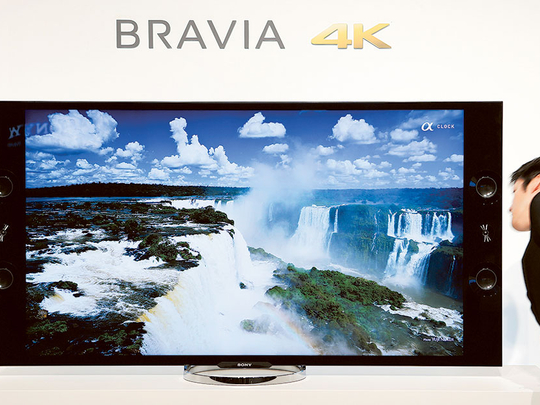
Dubai: Content for 4K TV is still an issue as none of the satellite broadcasters have started 4K broadcasting despite repeated trials.
Right now, Netflix, YouTube, Hulu and Amazon Prime are among the most common sources of 4K content.
Vinod Nair, general manager of Samsung Gulf Electronics’ CTV Business, said that the amount of 4K content is dramatically increasing as self-made content is growing due to the 4K cameras, camcorders and smartphones available in the market.
NBC is going to test its sports prowess on February 1 when it covers Super Bowl XLIX in 4K.
To improve 4K contents, TV manufacturers, broadcasters, content providers have announced a new UHD alliance to develop premium UHD contents for 4K TVs.
Nair said that UHD alliance is a global alliance and the idea is to create a unified platform.
The alliance was formed by DirecTV, LG, Netflix, Dolby, Panasonic, Samsung, Sharp, Sony Visual Product, Technicolor, The Walt Disney Studios, Twentieth Century Fox and Warner Bros Entertainment.
J.D. Lee, general manager of TV department at LG Electronics Gulf, said that the major concern for 4K content is the broadcasting — cable TV, free-to-air and satellite.
For streaming, he said that users need proper bandwidth and it is not easy for every country. Not many content providers have the required bandwidth for streaming.
“We are providing 4K movie contents on GoPro app which comes with the TV. It is limited as we buy the 4K movies from the studios. Buying too many contents are very expensive,” Lee said.
Sweta Dash, senior director for research and display at research firm IHS, said that the 4K content is growing and the upscaling technology [from 2K to 4K] is improving. The UHD alliance will really help the industry.
Shimpei Tsujigami, general manager of audio visual department at Panasonic marketing Middle East and Africa, said that the market demand is rapidly growing for 4K TVs.
“The success of the 4K TVs depends on the content. That is why we are launching 4K camcorders for users to create content,” he said.
Standard codec
Panasonic will be launching 4K sound bars, 4K Blu-ray players, 4K cameras and 4K camcorders in certain markets this year while LG will be launching its 4K Blu-ray players in the second half of this year. Samsung has no road map for 4K Blu-ray players now.
Even as the content is set to grow, the industry has not come to a standard 4K format.
There is a need for a standard codec that can deliver the ultra HD content, which has four times the resolution of Full HD and, at the same time, compress it down so that the data can fit within the home internet connection’s bandwidth.
Many are pushing with the new video codec called High Efficiency Video Coding (HEVC) or H. 265 instead of Advanced Video Coding or H. 264 format. Google is pushing with VP9 codec for 4K YouTube videos that can compress the video files to half the size than the current H. 264 format.
Dash said that HEVC will help in compression but needs wider bandwidth.
“The bandwidth required to stream HEVC format is 30 Mbps and for 8K is 100 Mbps. It is possible to stream even below the required bandwidth but the quality will not be good. HEVC is much better than MPEG2,” said Kohei Nakae, director of 8K technical production development at Japan Broadcasting Corporation (NHK).
He said that satellite broadcasters in Japan will launch 4K transmission in March. It will be two pay channels.
The industry hasn’t come to standard compression format, but he said that broadcasters across the world are looking at HEVC as the standard format in the US, UK, Japan, France and Germany.
By 2018, six broadcasters are expected to be broadcasting dedicated 4K channels.












